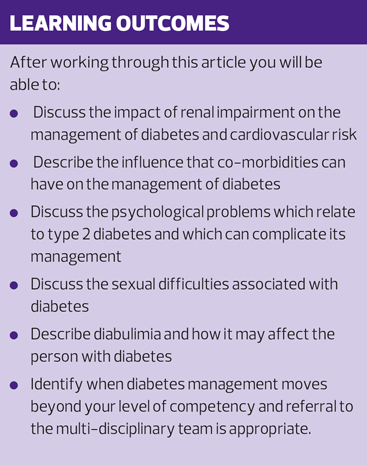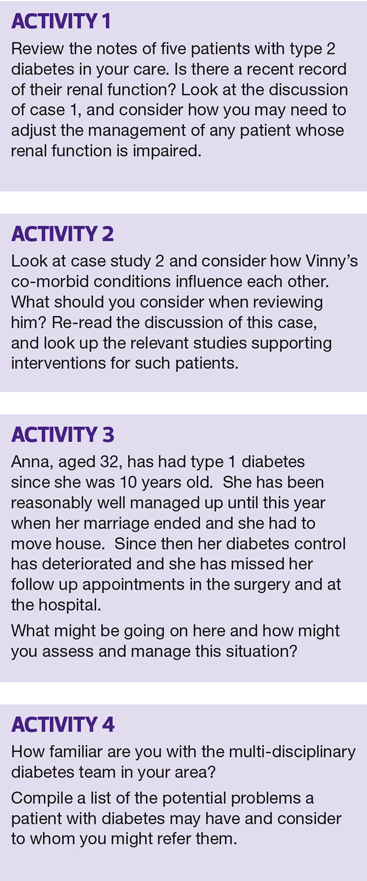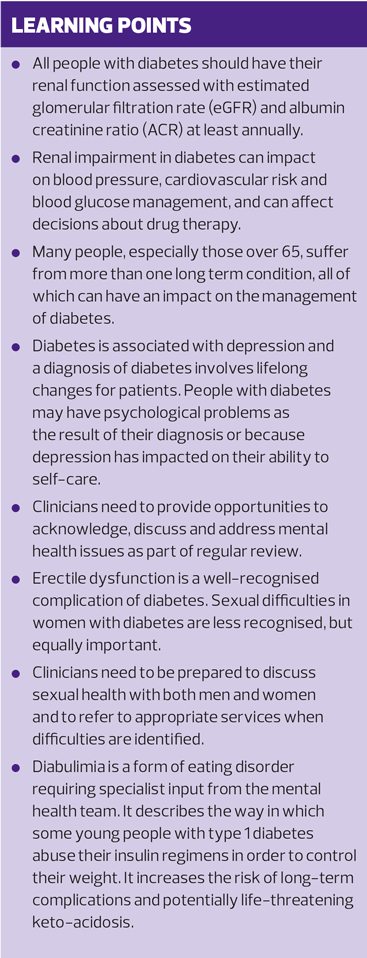Management dilemmas in complex diabetes
Beverley Bostock-Cox
Beverley Bostock-Cox
RGN MSc (Resp) MA (Med Ethics & Law) QN
Nurse Practitioner, Mann Cottage Surgery, Moreton in Marsh
Education Lead, Education for Health, Warwick
There are times when the management of diabetes may be more-than-usually challenging, and it is vital to be aware of the options in complex cases, and to recognise when you might need to involve the specialist multidisciplinary team
Diabetes is a complex condition, which requires the management of multiple factors in order to optimise outcomes and reduce the risk of complications. In this article we consider some of the aspects of diabetes care which can make the condition even more of a challenge to manage, and discuss possible options when addressing these issues.
RENAL IMPAIRMENT
The kidneys are important organs which help to maintain fluid balance as well as having other vital functions, including filtration, secretion and reabsorption. Healthy kidneys secrete renin, which helps to regulate blood pressure, reabsorb useful materials such as sugar, protein and vitamins during the filtration process, and assist with red blood cell production and maintaining bone health. If kidney function is impaired, there will be potential consequences for all of these areas. In diabetes, renal impairment can impact on blood pressure, cardiovascular risk and blood glucose management.1,2
Testing and diagnosis
Every person with diabetes should have their renal function checked at least annually with a blood test for estimated glomerular filtration rate (eGFR) and a urine test for albumin creatinine ratio (ACR). An abnormal reading in either test should be confirmed with a repeat test. Renal impairment is present if either test is confirmed as abnormal and will mean that the individual is at increased risk of both worsening renal impairment and cardiovascular disease (CVD).1,2 If both tests are abnormal those risks are increased and interventions aimed at reducing the risk should be implemented. In essence this means managing the blood pressure effectively with the maximum tolerated dose of an ACE inhibitor, introducing lifestyle changes (dietary changes, smoking cessation and increased activity levels) and medication such as statins.3
Impact on drug therapy
Renal impairment affects decisions about drug therapy for glycaemic control. Information about all of the drugs mentioned here is available through the Electronic Medicines Compendium.
Metformin doses should be reduced if the eGFR falls below 45ml/min and, if renal function continues to drop, consideration should be given to stopping the drug completely, because of the risk of lactic acidosis.4
SGLT2 inhibitors should not be initiated if the eGFR is below 60ml/min although empagliflozin and canagliflozin can be continued if the eGFR drops to 45ml/min (no lower) after initiation.
DPP4 inhibitors can be used in renal impairment but with dose adjustment. Linagliptin, however, is given at the same 5mg dose across all levels of eGFR as it is metabolised by the liver, not the kidneys. Pioglitazone can be used in renal impairment although it is important to recognise that people who have severe renal impairment will be at risk of renal bone disease and one of the side effects of pioglitazone is an increased fracture risk.5
Sulfonylureas and insulin are both likely to need dose reductions in people with renal impairment as failure of the kidneys to clear these drugs from the body normally may lead to an increased risk of hypoglycaemic events.6,7 There may be an increased risk of cardiovascular events in people who suffer from hypoglycaemia.8
The summary of product characteristics (SPC) for drugs will give advice on how to adjust dose in renal impairment. In some cases the recommendations are based on the estimated creatinine clearance (CrCl) rate, rather than eGFR. A quick online calculation (https://www.mdcalc.com/creatinine-clearance-cockcroft-gault-equation) will provide this figure, based on the individual’s age, sex, height, weight and creatinine.
Impact on cardiovascular risk
It is important to remember that the presence of renal impairment is linked to an increased risk of CVD, underlining the importance of aggressive risk factor management.2 Furthermore, if patients are identified as having renal impairment, it is important to consider any potential changes to current medication that may be needed in order to ensure that the patient is not being over-medicated, particularly if there are risks such as hypoglycaemia or cardiovascular events.
CASE STUDY
Heather, aged 58, has type 2 diabetes, diagnosed 12 years ago. She is on metformin 2g daily and also takes gliclazide 80mg bd. Her eGFR one year ago was 48ml/min but at a recent review it had dropped to 42ml/min. Her ACR is normal at 0.7mg/mmol. Her creatinine clearance rate is 38ml/min.
Discussion
Heather’s renal function means that consideration should be given to reducing her metformin dose to 500mg bd. As explained above, using sulfonylureas in renally impaired patients may increase the risk of hypoglycaemia and cardiovascular events. However, rather than adjusting the dose, it might be better to switch Heather to a drug which is licensed in renal impairment and does not put her at risk of hypoglycaemia. Choices might include sitagliptin 50mg, a lower dose than usually prescribed, based on Heather’s creatinine clearance, or linagliptin 5mg.
Her blood pressure should be tightly managed with an ACE inhibitor such as ramipril, which, in view of her renal impairment, should be prescribed with a maximum dose of 5mg.9 Other interventions should be put in place to reduce overall cardiovascular risk, including lifestyle changes and lipid lowering therapy where indicated.
CO-MORBIDITIES
Many people, especially those over 65, suffer from more than one long term condition.10 A patient with type 2 diabetes may also have asthma, chronic obstructive pulmonary disease (COPD), pre-existing cardiovascular disease, heart failure, joint problems, mental health problems or other long term conditions. All of these conditions have the potential to affect each other.
CASE STUDY 2
Vinny has type 2 diabetes and COPD. He had a myocardial infarction 5 years ago. He also suffers from osteoarthritis of the knees. He is currently taking metformin 2g daily, sitagliptin 100mg, a high dose (equivalent to 2000mcg) inhaled corticosteroid/long-acting beta 2 agonist (ICS/LABA), ramipril 10mg, atorvastatin 80mg and naproxen 250mg bd.
Discussion
All of Vinny’s co-morbid conditions need treating but the key is to ensure that he is getting the maximum benefit from his care and the minimum in terms of side effects and future risks to his health.
His diabetes and his history of a myocardial infarction put him at risk of heart failure in the future.11 It is useful to bear this in mind when considering future medication choices. Several studies have been undertaken looking at the risk of heart failure in people with diabetes who are treated with certain drug classes. In terms of the DPP4 inhibitors, for example, studies have reported on saxagliptin, sitagliptin and alogliptin. Studies on linagliptin in respect of heart failure are due to be reported in the future. The US Food and Drug Administration (FDA) issued a warning against alogliptin and saxagliptin,12 but the TECOS study showed no increased risk in people taking sitagliptin.13 Pioglitazone is contraindicated in heart failure.
As Vinny has a history of an MI, he is at high risk of another event in the future. It is therefore important to support him to do everything possible to reduce future events and to ensure that medication choices are made in line with optimising outcomes and minimising adverse events. The SGLT2 inhibitors are showing promising results in respect of cardiovascular risk. The EMPA-REG study was the first to report improved outcomes in people with a history of CVD who were treated with empagliflozin.14 The CANVAS study measured the impact of canagliflozin on people with and without a history of CVD and showed improvements in all-cause mortality and major adverse cardiac events.15
The use of ICS/LABA therapy in COPD has been associated with poorer diabetes control.16 The 2017 GOLD guidelines reflected a move away from ICS/LABAs for people with COPD who did not suffer from regular exacerbations and suggested that bronchodilators (single or dual) should, instead, be the mainstay of treatment.17 These two factors indicate that Vinny’s COPD treatment should be reviewed. He may not need an ICS at all and can therefore be taken off this treatment and given a LABA or a long acting muscarinic antagonist, or both, instead. This would potentially optimise his lung function, reduce his risk of exacerbations and help to improve his diabetes control.
Vinny is on atorvastatin 80mg, the recommended dose following a diagnosis of acute coronary syndrome.18 Interestingly there is some evidence to suggest that people with COPD who take a statin have a lower risk of exacerbations compared with those who do not.19
Vinny’s use of non-steroidal anti-inflammatory drugs (NSAIDs) for osteoarthritis needs addressing. NSAIDs can have adverse effects on renal function, gastric health and cardiovascular risk.20 The impact on the kidney and cardiovascular system are of particular importance in people with diabetes. Vinny would benefit from a review of his NSAID use and consideration of different ways in which his joint pain can be managed effectively while reducing any potential harm from the treatment. Non-pharmacological interventions might include thermotherapy, using heat and cold to reduce pain and swelling, or he could try topical treatments, including those which contain no NSAIDs, such as capsaicin.21 Weight loss, where appropriate, will help to reduce pressure on the knees so Vinny should be encouraged to eat healthily (which should be part of his diabetes management anyway). He can also be advised to take regular exercise. This will benefit (not harm) his joints and will also help to improve his metabolic health, including his diabetes, blood pressure and lipid profile.
PSYCHOLOGICAL PROBLEMS
Diabetes, like many other long term conditions, is associated with an increased risk of depression. In diabetes, however, labile blood glucose levels are thought to have a specific impact on mental health.22 Good glycaemic control can have a beneficial effect on both physical and mental well-being.
In previous years the Quality Outcomes Framework (QOF) rewarded practices for assessing the mental health of people with diabetes using the two question approach:
1. During the past month, have you often been bothered by feeling down, depressed, or hopeless?
2. During the past month, have you often been bothered by little interest or pleasure in doing things?
However, since this is no longer a QOF requirement, people with diabetes may not be asked about their mental wellbeing and the opportunity to identify people with diabetes-related problems may be missed.
A diagnosis of diabetes means lifelong changes: the need to take regular medication, attend an array of appointments and check-ups, maintain a healthy weight and diet and take regular activity. For many people this will mean the loss of things they have previously enjoyed, a feeling of guilt when they relapse, and the feeling of being a ‘patient’ without necessarily having any symptoms. This can result in so-called ‘diabetes distress’ or ‘diabetes burnout’.23 These individuals have to manage their diabetes every day and, if they are suffering from low mood as the result of depression, their ability to maintain a high level of self-care is likely to be diminished.
Health care professionals and carers should be aware that people with diabetes may have psychological problems, as the result of their diagnosis or because depression has impacted on their ability to self-care. Opportunities to discuss, acknowledge and address mental health issues are an important part of a diabetes review. Attendance at groups such as those run by Diabetes UK, or the online forums provided by organisations such as diabetes.co.uk may help people to feel less isolated. Where appropriate, referral can be made for psychological support using ‘talking’ or cognitive behavioural therapy and, in some cases, medication such as SSRIs may be prescribed.
SEXUAL DIFFICULTIES
The association between erectile dysfunction (ED) and diabetes is well known although since the requirement to ask men with diabetes about ED was also removed from QOF, fewer men are likely to be asked about it. Nonetheless, the loss of a sexual relationship can have a significant effect on holistic wellbeing and relationships.
The impact of diabetes on women’s sexual health is talked about far less than ED and this was reflected in QOF’s former inclusion of ED without a similar question being asked of women. Studies of women’s sexual health following a diagnosis of diabetes suggest that the condition can lead to problems with lubrication, clitoral sensitivity, arousal and orgasm, all of which can have as much of an effect on sexual and personal relationships as ED.
Clinicians should therefore be prepared to ask both men and women about sexual health issues as part of the diabetes review, even though it is no longer necessary for QOF. If problems are identified, referral to the appropriate services should be offered.
RECOGNISING DIABULIMIA
Diabulimia is an unofficial term that combines ‘diabetes’ and ‘bulimia’. It is used to describe the way in which some young people with type 1 diabetes abuse their insulin regimens, taking less than they need as a way of controlling their weight. The hyperglycaemia which results from doing this leads to fat breakdown and weight loss, as often happens in type 1 diabetes pre-diagnosis.
People with diabulimia are at increased risk of developing diabetic ketoacidosis, which can be life-threatening. They are also at increased risk of the long term complications of diabetes such as macrovascular and microvascular complications.
Diabulimia is recognised (albeit not yet officially) as a form of eating disorder requiring specialist input from the mental health team. Support can also be accessed via the ‘Diabetics with Eating Disorders’ website: http://dwed.org.uk/ or via Diabetes UK: https://www.diabetes.org.uk/guide-to-diabetes/life-with-diabetes/diabulimia
REFERRAL TO THE MULTI-DISCIPLINARY TEAM
Diabetes is a complex condition that requires management of multi-factorial elements in order to optimise outcomes and minimise harm. As more diabetes management is devolved to primary care, general practice nurses (GPNs) may find themselves carrying out annual reviews on patients with more complex needs. It is therefore essential that you remember your accountability and work within your code of conduct and to your own, individual, level of competence.
The diabetes team extends far beyond primary care and includes the GP, the diabetologist, diabetes specialist nurses, community nurses, podiatrists, dieticians, psychologists, sexual health specialists and others who are all able to support people with diabetes to live as healthily as possible. It is important to get to know the services and people available locally to ensure that everyone is able to access the best standard of care.
SUMMARY
Diabetes management can be complicated by renal impairment, cardiovascular risk, co-morbidities, psychological problems, sexual difficulties, diabulimia and other issues. GPNs should understand the need to recognise these problems and ensure that patients get the support that they need. This includes knowing when to refer on for specialist support from the multi-disciplinary team.
REFERENCES
1. NICE NG28. Type 2 diabetes in adults – management. 2015, updated 2017 https://www.nice.org.uk/guidance/ng28
2. NICE CG182. Chronic kidney disease in adults: assessment and management. 2104, updated 2015 https://www.nice.org.uk/guidance/cg182
3. NICE CG127. Hypertension in adults: diagnosis and management. 2011, updated 2016 https://www.nice.org.uk/guidance/cg127
4. Fitzgerald E. Metformin associated lactic acidosis. BMJ 2009; 339 b3660 http://www.bmj.com/content/339/bmj.b3660
5. Billington EO, Grey A, Bolland MJ. The effect of thiazolidinediones on bone mineral density and bone turnover: systematic review and meta-analysis. Diabetologia 2015; 58(10):2238-2246 https://link.springer.com/article/10.1007/s00125-015-3660-2
6. Ioannidis I. Diabetes treatment in patients with renal disease: Is the landscape clear enough? World J Diabetes 2014;5(5):651-658. doi:10.4239/wjd.v5.i5.651.
7. Van Dalem J, Brouwers MCGJ, Stehouwer CDA, et al. Risk of hypoglycaemia in users of sulphonylureas compared with metformin in relation to renal function and sulphonylurea metabolite group: population based cohort study. BMJ 2016;354:i3625 http://www.bmj.com/content/354/bmj.i3625
8. Frier BM, Schernthaner G, Heller SR. Hypoglycemia and Cardiovascular Risks. Diabetes Care 2011;34(Suppl 2):S132-S137. doi:10.2337/dc11-s220.
9. EMC 2015. Ramipril 10mg capsules https://www.medicines.org.uk/emc/medicine/30876
10. Banerjee S. Multimorbidity – older adults need healthcare that can count past one. The Lancet 2015; 385(9968):587-589 http://www.thelancet.com/journals/lancet/article/PIIS0140-6736(14)61596-8/abstract
11. NICE CG108. Chronic heart failure in adults: management. 2010 https://www.nice.org.uk/guidance/cg108
12. US Food and Drug Administration. Diabetes medications containing saxagliptin and alogliptin: Drug Safety Communication - Risk of Heart Failure. 2016 https://www.fda.gov/Safety/MedWatch/SafetyInformation/SafetyAlertsforHumanMedicalProducts/ucm494252.htm
13. Green JB, Bethel MA, Armstrong PW, et al. Effect of sitagliptin on cardiovascular outcomes in type 2 diabetes. N Engl J Med 2015;373:232-242 http://www.nejm.org/doi/full/10.1056/NEJMoa1501352#t=article
14. Zinman B, Wanner C, Lachin JM, et al. Empagliflozin, cardiovascular outcomes, and mortality in type 2 diabetes. N Engl J Med 2015;373:2117-2128 http://www.nejm.org/doi/full/10.1056/NEJMoa1504720
15. Neal B, Perkovic V, Mahaffley KW, et al. Canagliflozin and cardiovascular and renal events in type 2 diabetes. N Engl J Med 2017;377:644-657 http://www.nejm.org/doi/full/10.1056/NEJMoa1611925
16. Price DB, Russell R, Mares R, et al. Metabolic Effects Associated with ICS in Patients with COPD and Comorbid Type 2 Diabetes: A Historical Matched Cohort Study. PLoS ONE 2016; 11(9): e0162903. doi:10.1371/journal.pone.0162903
17. GOLD. Global strategy for the diagnosis, management and prevention of COPD. 2017 http://goldcopd.org/gold-2017-global-strategy-diagnosis-management-prevention-copd/
18. Ray KK, Cannon CP, McCabe CH, et al. Early and late benefits of high-dose atorvastatin in patients with acute coronary syndromes: results from the PROVE IT-TIMI 22 trial. J Am Coll Cardiol. 2005;46(8):1405-1410 https://www.ncbi.nlm.nih.gov/pubmed/16226162
19. Cao C, Wu Y, Xu Z, et al. The effect of statins on chronic obstructive pulmonary disease exacerbation and mortality: a systematic review and meta-analysis of observational research. Scientific Reports 2015;5:16461. doi:10.1038/srep16461.
20. Arthritis Research UK. NSAID side effects, 2017 https://www.arthritisresearchuk.org/arthritis-information/drugs/nsaids/possible-side-effects.aspx
21. Arthritis Research UK. Arthritis information, 2017 https://www.arthritisresearchuk.org/arthritis-information.aspx
22. Macnamee D. High blood sugar raises ‘depression risk’ in diabetics. Medical News Today 2014 https://www.medicalnewstoday.com/articles/278640.php
23. Diabetes UK 2017. Diabetes burnout https://www.diabetes.org.uk/guide-to-diabetes/life-with-diabetes/diabetes-burnout
24. Doruk H, Akbay E, Cayan S, et al. Effect of diabetes mellitus on female sexual function and risk factors. Archives of Andrology 2005;51(1):1-6 https://www.ncbi.nlm.nih.gov/pubmed/15764412
Related articles
View all Articles



